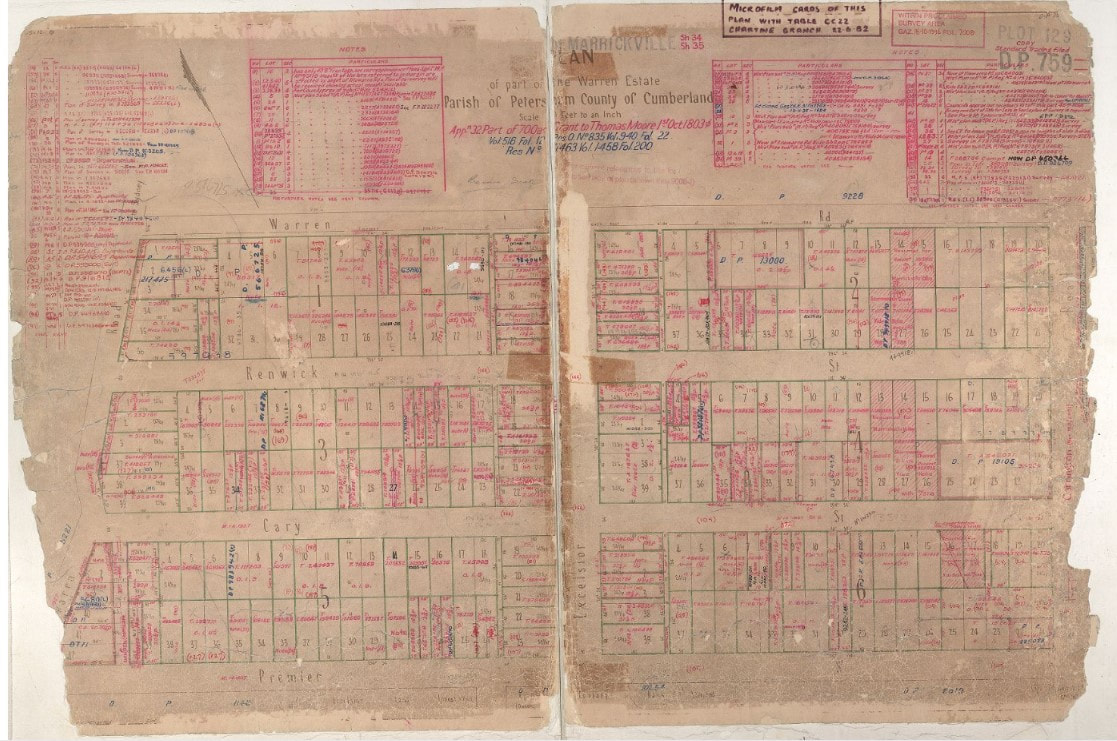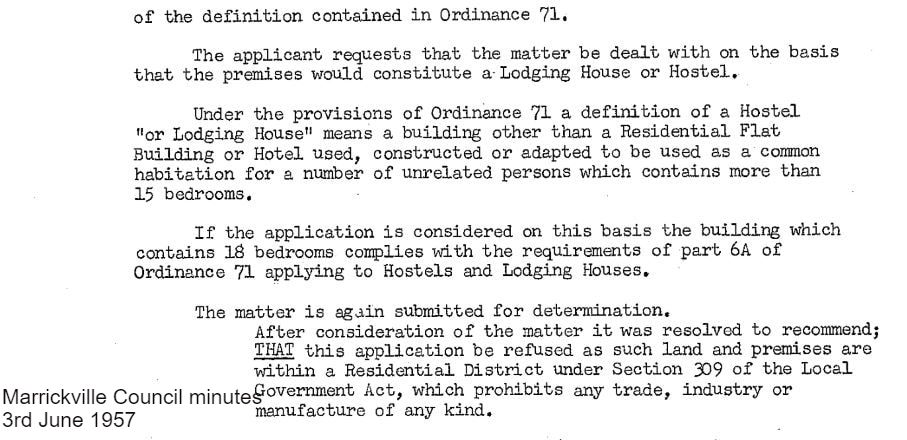27 Premier street
da201900204 demolition application
A tale of two houses
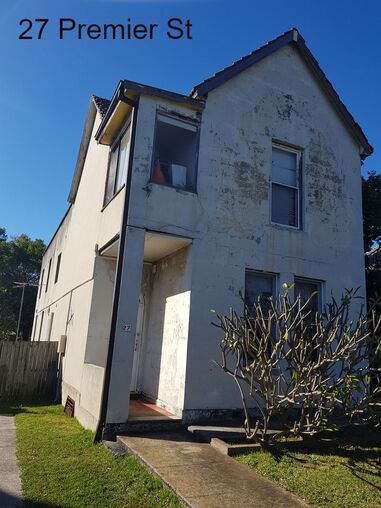
Watching Marrickville boom in the 1880’s would have been exhilarating. Its conversion from sleepy rural hamlet to upmarket suburb was in progress and its wealthy inhabitants were snapping up subdivided lots to build their grand dream homes. After nearly 100 years of settlement, the City of Sydney was congested, smelly and fraught with infection. Marrickville provided an escape for those who could afford to uproot their family and move to the affluent suburb. The government was keen to move the crowds out of the metropolitan area as well. They funded a tramline from Newtown to the corner of Marrickville and Illawarra Roads which opened in 1881. By 1884, Marrickville had a train station (where Sydenham Station is now) as did Tempe.
The Excelsior Land and Building Company was at the ready and fully poised to take advantage of the excitement generated by having easy access to the City as well as a suburban infrastructure for families to enjoy. They had purchased vast tracts of Thomas Holt’s land (the old Warren estate) and had roads named and allotments pegged out. The suburb of Marrickville was coming into its own. Grand villas were appearing around the suburb and now ‘The Warren’ was about to seduce Sydney’s wealthy and successful to its streets.
Deposited Plan 759 was lodged and lots were offered for sale in 1883. Its boundaries were Premier St, Illawarra Rd, Warren Rd and Carrington Rd.
The Excelsior Land and Building Company was at the ready and fully poised to take advantage of the excitement generated by having easy access to the City as well as a suburban infrastructure for families to enjoy. They had purchased vast tracts of Thomas Holt’s land (the old Warren estate) and had roads named and allotments pegged out. The suburb of Marrickville was coming into its own. Grand villas were appearing around the suburb and now ‘The Warren’ was about to seduce Sydney’s wealthy and successful to its streets.
Deposited Plan 759 was lodged and lots were offered for sale in 1883. Its boundaries were Premier St, Illawarra Rd, Warren Rd and Carrington Rd.
Two Sydney men decided that Premier Street would be the perfect spot to raise their families. They were Nathan Hollingworth who bought lot 33 in early 1884 and James Martin Macadam who bought the neighbouring lot 32 at the end of that year. They were early settlers into the street. In 1885 there were only 7 homes in Premier Street, by 1886 there were 12 including Nathan’s and James’.
Nathan moved to Marrickville from Crown Street Surry Hills with his wife Ann and their eight surviving children. Their family story was one of joy and heartbreak that was being repeated ad nauseum across Sydney. Little William had died at age 5 despite being sent out to the fresh air near Ryde. Within 5 years of arriving at Premier Street, two more had died. But the remaining six children, who came to Marrickville at a range of ages from one year old through to 21 lived a blissful existence on the heights above the river.
Nathan moved to Marrickville from Crown Street Surry Hills with his wife Ann and their eight surviving children. Their family story was one of joy and heartbreak that was being repeated ad nauseum across Sydney. Little William had died at age 5 despite being sent out to the fresh air near Ryde. Within 5 years of arriving at Premier Street, two more had died. But the remaining six children, who came to Marrickville at a range of ages from one year old through to 21 lived a blissful existence on the heights above the river.
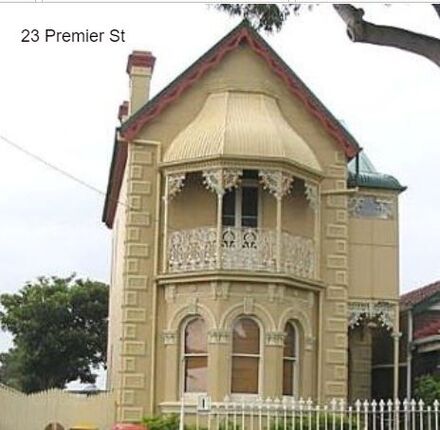
Nathan and Ann called their home Charlton Kings and remained there until the end of their lives. Nathan spent 43 years working for the Government Printing Office and died quietly in 1916. Ann followed in 1925. Their daughter Lillias inherited the house, subdivided the land and sold part to William Watts, a builder from Marrickville. He built a bungalow on what is now 25 Premier Street and sold it shortly afterwards. Nathan’s house has passed through the hands of several families and although it no longer stands on its imposing piece of land it has maintained its dignity and beauty thanks to the care of its attentive owners. It is number 23 Premier Street.
James clearly thought Charlton Kings was a beauty. He built his house as the mirror image of Nathan’s. They created a commanding streetscape in their early years, two grand villas each on a 50 foot block facing each other across vast lawns. But although built identically, the story of James’ house at 27 Premier Street is a vastly different one.
James clearly thought Charlton Kings was a beauty. He built his house as the mirror image of Nathan’s. They created a commanding streetscape in their early years, two grand villas each on a 50 foot block facing each other across vast lawns. But although built identically, the story of James’ house at 27 Premier Street is a vastly different one.
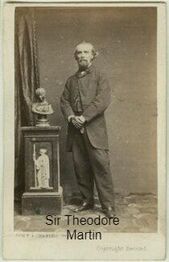
James had been a sailor travelling the world but settled in Woolloomooloo and worked as a clerk. He eventually climbed his way up to manager of the Atlas Assurance Company. He had married Elizabeth Magovney in 1881 and they had two small children when they arrived in Premier Street. Two more were born within 3 years of moving in. They were more than 20 years younger than the Hollingworths next door but their children were similar in age to the two youngest neighbours. They didn’t appear to socialise much together – Nathan was active in the Free Church, James was a prominent Presbyterian. Nathan was the son of a labourer, James’ father was a banker. They didn’t attend the same social events and weddings but they were united by their houses.
James named his house Bryntsylios, after a castle in Wales. It was a grand sounding name but the Welsh castle was owned by his uncle Sir Theodore Martin, a renowned Scottish poet and the biographer of Prince Albert. He was a lifelong friend of Queen Victoria. Sir Theodore had married an actress Helen Faucit but they had no children and after Lady Helen died in 1898, James became Sir Theodore’s heir. He died in 1909, and James travelled to Britain to settle the estate. After many bequests James inherited the balance of Sir Theodore’s estate, valued at around £130,000, an enormous sum for the period. At the time, James had already moved from Premier Street and was living at Kirribilli Point, in a house he also called Bryntsylios. After receiving the inheritance, he upgraded to Darling Point (yes that house was called Bryntsylios too), but had little time to enjoy his new found wealth, as he died in 1913 while on a trip to New Zealand.
The Macadam’s had sold Bryntsylios to Henry Morton Holbeach in 1906 who promptly changed the name of the house to “The Laurels”. He lived there with his wife and three small children for 6 years before moving to Union Street Tempe. Henry became an alderman on St Peters Council in 1931. In 1932 he was elected mayor, then again in 1933. After a year off he again became mayor in 1935 but only lasted for half of his term as he died in office.
Eventually the house was sold to Michael Mulcahy, a Marrickville real estate agent. He used the house as a rental property with a series of short term tenants moving through the house from 1923 until 1956. The house was in a sad state by the time the Mulcahy’s offloaded it.
It was sold to Joseph Virgona, a fruit shop owner from Neutral Bay. In 1957 he submitted a development application for “alterations and extension of the residence”. Council interpreted the plans as an attempt to turn the house into “flatettes”. Although they felt that the plans represented an improvement on the building’s current state, they would not approve the application as it breached Ordinance 71 of the Local Government Act.
James named his house Bryntsylios, after a castle in Wales. It was a grand sounding name but the Welsh castle was owned by his uncle Sir Theodore Martin, a renowned Scottish poet and the biographer of Prince Albert. He was a lifelong friend of Queen Victoria. Sir Theodore had married an actress Helen Faucit but they had no children and after Lady Helen died in 1898, James became Sir Theodore’s heir. He died in 1909, and James travelled to Britain to settle the estate. After many bequests James inherited the balance of Sir Theodore’s estate, valued at around £130,000, an enormous sum for the period. At the time, James had already moved from Premier Street and was living at Kirribilli Point, in a house he also called Bryntsylios. After receiving the inheritance, he upgraded to Darling Point (yes that house was called Bryntsylios too), but had little time to enjoy his new found wealth, as he died in 1913 while on a trip to New Zealand.
The Macadam’s had sold Bryntsylios to Henry Morton Holbeach in 1906 who promptly changed the name of the house to “The Laurels”. He lived there with his wife and three small children for 6 years before moving to Union Street Tempe. Henry became an alderman on St Peters Council in 1931. In 1932 he was elected mayor, then again in 1933. After a year off he again became mayor in 1935 but only lasted for half of his term as he died in office.
Eventually the house was sold to Michael Mulcahy, a Marrickville real estate agent. He used the house as a rental property with a series of short term tenants moving through the house from 1923 until 1956. The house was in a sad state by the time the Mulcahy’s offloaded it.
It was sold to Joseph Virgona, a fruit shop owner from Neutral Bay. In 1957 he submitted a development application for “alterations and extension of the residence”. Council interpreted the plans as an attempt to turn the house into “flatettes”. Although they felt that the plans represented an improvement on the building’s current state, they would not approve the application as it breached Ordinance 71 of the Local Government Act.
Joseph modified the plans and resubmitted them, this time as an 18 room lodging house. Although the plans now complied with Ordinance 71, Council rejected the application on the basis that Premier Street was a residential area and a lodging house was not considered residential in nature.
Joseph converted the house into four flats without permission. Numerous notices were served on him between October 1959 and July 1965 by the Chief Health Inspector to no avail and with no consequence. In 1984 the house was inherited by Joseph’s three children and the illegal land usage continued. The Statement of Environmental Effects attached to DA201900204 admits to the flats being illegal, consistent with modern popular strategy of asking for forgiveness instead of permission.
The house is a shadow of its former self and its twin two doors down serves as a painful reminder of the indignities that have been perpetrated upon number 27. It has lost its balcony, bay window and chimneys. It has had windows punched into its side where they ought not to be. Large cracks are apparent in the structure. The house has been completely stripped of all embellishment. Its final degradation is to face the wrecking ball.
The story of this house’s decline from grand villa to fractured rental shines a light on a development process where absent homeowners describe themselves as investors, treat the improvements on the land as expendable assets and legitimise the destruction of neighbourhood streetscape and the irreplaceable heritage of our community. This house has been sweated for more than half a century with little care or attention paid to it. Now that it has deteriorated beyond liveable, the owners want it gone.
Nobody would begrudge a subdivision of the land, it is more than able to carry an additional home. But to deliberately destroy what was once a great beauty and a much loved family home is unforgiveable.
Copyright © 2019 Marrickville Unearthed. All rights reserved.
The house is a shadow of its former self and its twin two doors down serves as a painful reminder of the indignities that have been perpetrated upon number 27. It has lost its balcony, bay window and chimneys. It has had windows punched into its side where they ought not to be. Large cracks are apparent in the structure. The house has been completely stripped of all embellishment. Its final degradation is to face the wrecking ball.
The story of this house’s decline from grand villa to fractured rental shines a light on a development process where absent homeowners describe themselves as investors, treat the improvements on the land as expendable assets and legitimise the destruction of neighbourhood streetscape and the irreplaceable heritage of our community. This house has been sweated for more than half a century with little care or attention paid to it. Now that it has deteriorated beyond liveable, the owners want it gone.
Nobody would begrudge a subdivision of the land, it is more than able to carry an additional home. But to deliberately destroy what was once a great beauty and a much loved family home is unforgiveable.
Copyright © 2019 Marrickville Unearthed. All rights reserved.
